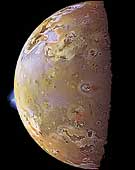|
COMETS EARTH JUPITER KUIPER BELT MARS MERCURY METEORITES NEPTUNE OORT CLOUD PLUTO SATURN SOLAR SYSTEM SPACE SUN URANUS VENUS ORDER PRINTS
PHOTO CATEGORIES SCIENCEVIEWS AMERICAN INDIAN AMPHIBIANS BIRDS BUGS FINE ART FOSSILS THE ISLANDS HISTORICAL PHOTOS MAMMALS OTHER PARKS PLANTS RELIGIOUS REPTILES SCIENCEVIEWS PRINTS
|
Related Document
Download Options
This color image, acquired during Galileo's ninth orbit (C9) around Jupiter, shows two volcanic plumes on Io. One plume was captured on the bright limb or edge of the moon, erupting over a caldera (volcanic depression) named Pillan Patera. The plume seen by Galileo is 140 kilometers (86 miles) high, and was also detected by the Hubble Space Telescope. The Galileo spacecraft will pass almost directly over Pillan Patera in 1999 at a range of only 600 (373 miles). The second plume, seen near the terminator, the boundary between day and night, is called Prometheus after the Greek fire god). The shadow of the airborne plume can be seen extending to the right of the eruption vent. (The vent is near the center of the bright and dark rings). Plumes on Io have a blue color, so the plume shadow is reddish. The Prometheus plume can be seen in every Galileo image with the appropriate geometry, as well as every such Voyager image acquired in 1979. It is possible that this plume has been continuously active for more than 18 years. In contrast, a plume has never been seen at Pillan Patera prior to the recent Galileo and HST images. Color images from orbit C9 have been merged with a high resolution mosaic of images acquired in various orbits to enhance the surface detail. PIA00703 is another version of this image which also includes detailed insets of the plumes. North is to the top of the picture. The resolution is about 2 kilometers (1.2 miles) per picture element. This composite uses images taken with the green, violet, and near-infrared filters of the Solid State Imaging (CCD) system on NASA's Galileo spacecraft. The C9 images were obtained on June 28, 1997 at a range of more than 600,000 kilometers (372,000 miles). |
